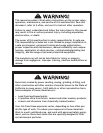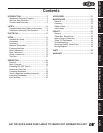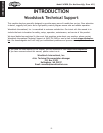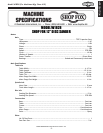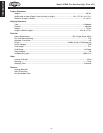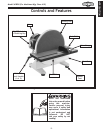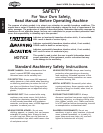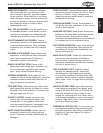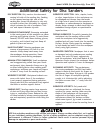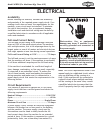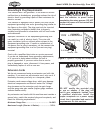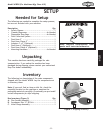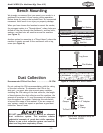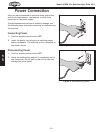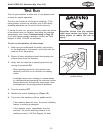
Model W1828 (For Machines Mfg. Since 4/11)
-8-
SAFETY
Additional Safety for Disc Sanders
DISC DIRECTION. Only sand on the downward-
moving left side of the sanding disc. Sanding
on the upward-moving right side of the
sanding disc forces the operator to rely only
on hands (rather than the table) for support,
which increases the risk of workpiece "kick-
out" and impact/abrasion injuries.
AVOIDING ENTANGLEMENT. Becoming entangled
in the moving parts of this machine can cause
pinching and crushing injuries. To avoid these
hazards, DO NOT wear loose clothing, gloves,
or jewelry, and tie back long hair. Keep all
guards in place and secure.
HAND PLACEMENT. Rotating sandpaper can
remove a large amount of flesh in a few
seconds. Always keep hands away from
the sandpaper during operation. Never
intentionally touch moving sandpaper.
MINIMUM STOCK DIMENSION. Small workpieces
can be aggressively pulled from your hands
and present injury hazards. Always use a jig
or other holding device when sanding small
workpieces, and keep your hands and fingers
at least 2" away from the sanding surface.
WORKPIECE SUPPORT. Workpiece kickback can
occur with violent force if the workpiece
is not properly supported during operation.
Always sand with the workpiece firmly against
the table or another support device.
SANDING DUST. Sanding creates large amounts
of dust and flying chips that can lead to eye
injury or respiratory illness. Reduce the risk
of these hazards by always wearing approved
eye and respiratory protection when using the
sander.
WORKPIECE INSPECTION. Nails, staples, knots,
or other imperfections in the workpiece can
be dislodged and thrown from the sander
at a high rate of speed into the operator or
bystanders, or cause damage to sandpaper or
sander. Never attempt to sand stock that has
embedded foreign objects or questionable
imperfections.
FEEDING WORKPIECE. Forcefully jamming the
workpiece into the sanding surface could
cause the workpiece to be aggressively
grabbed and pull your hands into the sanding
surface. Always firmly grasp the workpiece
in both hands and ease it into the sandpaper
slowly using light pressure.
SANDPAPER CONDITION. Sandpaper that is worn
or damaged not only produces poor sanding
results, but could fly apart, aggressively
grab the workpiece, and throw debris at the
operator. Always inspect the sandpaper before
operation and replace it if worn or damaged.
IN-RUNNING NIP POINTS. The gap between
the moving sandpaper and the fixed table/
support creates a pinch point for fingers or
workpieces; the larger this gap is, the greater
the risk of fingers or workpieces getting
caught in it. Minimize this risk by adjusting
the table no more than
1
⁄16" away from the
sandpaper.
WORKPIECE INTEGRITY. Only sand solid
workpieces that can withstand the forces
required for power sanding. Make sure the
shape of the workpiece can be properly
supported on the table; avoid sanding
workpieces without flat bottom surfaces
unless some type of jig is used to maintain
support and control when the sanding force is
applied.
USE this and other machinery with caution and respect. Always consider safety first, as it applies
to your individual working conditions. No list of safety guidelines can be complete—every shop
environment is different. Failure to follow guidelines could result in serious personal injury,
damage to equipment or poor work results.



